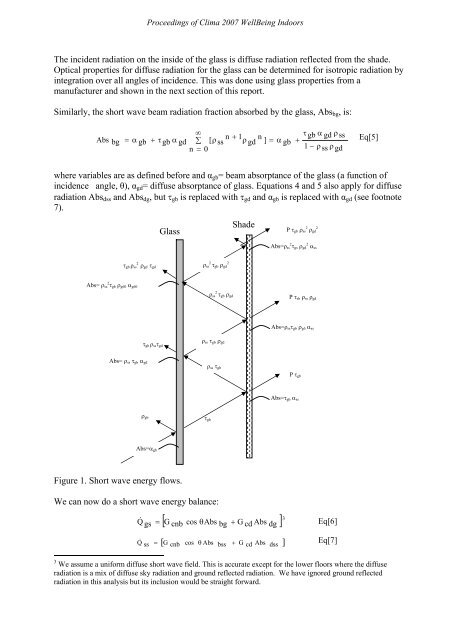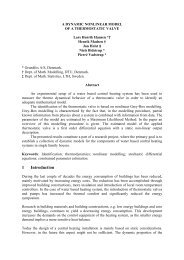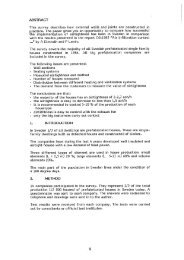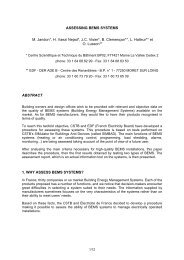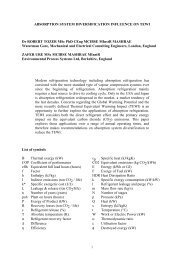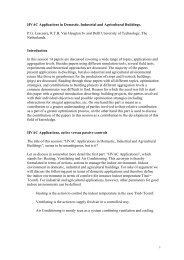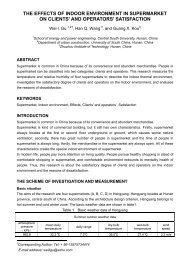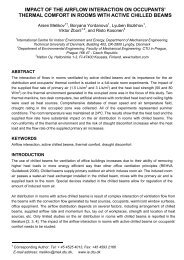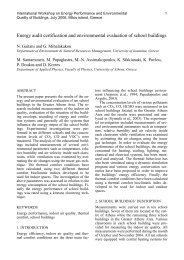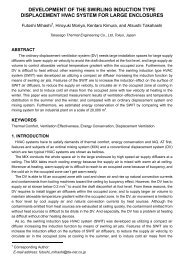Modeling the Heat Gain of a Window With an Interior Shade ... - inive
Modeling the Heat Gain of a Window With an Interior Shade ... - inive
Modeling the Heat Gain of a Window With an Interior Shade ... - inive
You also want an ePaper? Increase the reach of your titles
YUMPU automatically turns print PDFs into web optimized ePapers that Google loves.
Proceedings <strong>of</strong> Clima 2007 WellBeing Indoors<br />
The incident radiation on <strong>the</strong> inside <strong>of</strong> <strong>the</strong> glass is diffuse radiation reflected from <strong>the</strong> shade.<br />
Optical properties for diffuse radiation for <strong>the</strong> glass c<strong>an</strong> be determined for isotropic radiation by<br />
integration over all <strong>an</strong>gles <strong>of</strong> incidence. This was done using glass properties from a<br />
m<strong>an</strong>ufacturer <strong>an</strong>d shown in <strong>the</strong> next section <strong>of</strong> this report.<br />
Similarly, <strong>the</strong> short wave beam radiation fraction absorbed by <strong>the</strong> glass, Abs bg , is:<br />
Abs bg<br />
∞<br />
n 1 n<br />
τ gb α gd ρss<br />
= α gb + τ gb α gd ∑ [ ρ<br />
+<br />
ss ρ gd ] = α gb +<br />
Eq[5]<br />
n = 0<br />
1 − ρ ss ρ gd<br />
where variables are as defined before <strong>an</strong>d α gb = beam absorpt<strong>an</strong>ce <strong>of</strong> <strong>the</strong> glass (a function <strong>of</strong><br />
incidence <strong>an</strong>gle, θ), α gd = diffuse absorpt<strong>an</strong>ce <strong>of</strong> glass. Equations 4 <strong>an</strong>d 5 also apply for diffuse<br />
radiation Abs dss <strong>an</strong>d Abs dg , but τ gb is replaced with τ gd <strong>an</strong>d α gb is replaced with α gd (see footnote<br />
7).<br />
Glass<br />
<strong>Shade</strong><br />
P τ gb ρ ss 2 ρ gd<br />
2<br />
Abs=ρ ss 2 τ gs ρ gd 2 α ss<br />
τ gb ρ ss<br />
2<br />
ρ gd τ gd ρ ss<br />
2<br />
τ gb ρ gd<br />
2<br />
Abs= ρ ss 2 τ gb ρ g60 α g60<br />
ρ ss<br />
2<br />
τ gb ρ gd<br />
P τ sb ρ ss ρ gd<br />
Abs=ρ ss τ gb ρ gδ α ss<br />
τ gb ρ ss τ gd<br />
ρ ss τ gb ρ gd<br />
Abs= ρ ss τ gb α gd<br />
ρ ss τ gb<br />
P τ gb<br />
Abs=τ gb α ss<br />
ρ gb<br />
τ gb<br />
Abs=α gb<br />
Figure 1. Short wave energy flows.<br />
We c<strong>an</strong> now do a short wave energy bal<strong>an</strong>ce:<br />
[ cos θAbs<br />
G cd Abs ]<br />
& 3<br />
Q gs = G cnb bg +<br />
dg<br />
Eq[6]<br />
& = [ cos θ Abs<br />
Abs ] Eq[7]<br />
Q ss G cnb<br />
bss + G cd<br />
3 We assume a uniform diffuse short wave field. This is accurate except for <strong>the</strong> lower floors where <strong>the</strong> diffuse<br />
radiation is a mix <strong>of</strong> diffuse sky radiation <strong>an</strong>d ground reflected radiation. We have ignored ground reflected<br />
radiation in this <strong>an</strong>alysis but its inclusion would be straight forward.<br />
dss


